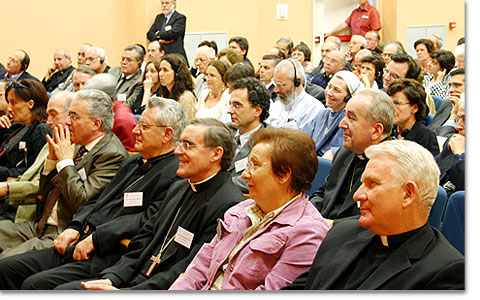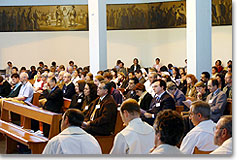 |
 |
Misa durante el congreso
Mass during the congress
Messe beim Kongress |
|
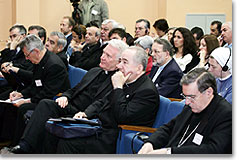 |
 |
Centro: Mons. Rylko, Mons. Clemens
Center: Bishops Rylko, and Clemens
Mitte: Erzbischof Rylko, Bischof Clemens |
|
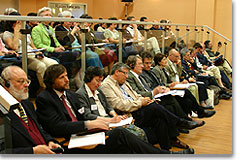 |
 |
Congreso Mundial de los Movimientos en Rocca di Papa
World Congreso of the Movements in Rocca di Papa
Weltkongress der Bewegungen in Rocca di Papa |
|
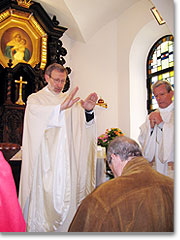 |
 |
Juan José Coeymans: bendición en el Santuario Original
Juan José Coeymans: blessing in the Original Shrine
Juan José Coeymans: Segen im Urheiligtum
Fotos: Vinculo © 2006 |
|
| |
|
ROME, Octavio Galarce B. The 2nd World Congress of Ecclesial
Movements and New Communities, convened by Benedict XVI, was held from
May 31st to June 2nd in Rocca di Papa on the outskirts
of Rome near Lake Albano. The main theme for the Congress was: "The
beauty of being a Christian and the joy of communicating it".
Juan Enrique Coeymans, who is from Chile, is a member of the Federation
of Families and served as one of four representatives for the Movement,
helping to explain Schoenstatt’s mission and contribution to the 280 delegates.
The Congress began with a round table discussion on the first two days,
after which the delegates from the Movements and the Communities could
comment for up to three minutes on the subjects that had been discussed.
Because of the overarching importance and significance of this Congress,
we wanted to interview Juan Enrique about his experiences and the results
of his involvement.
How was your participation in the Congress arranged? Who extended the
invitation?
-I do not know how my participation was arranged to represent the Movement.
The only thing I know is that Father Ivan Simicic, National Director of
the Movement in Chile, told me that the General Presidency of the Schoenstatt
Work, which is the highest collegiate body of the Schoenstatt Work in
the world, had decided that I was to be one of the four representatives.
He asked me if I was willing to assume this role of representative. The
truth is that I did not hesitate one second in saying "yes," even though
it was an honor I did not deserve. Because it was also a great opportunity
to make contact with people from other Movements, living Founders, and
so forth, and it was an event that simply could not be missed.
Schoenstatt was represented by Father Michael Marmann, former General
Superior of the Schoenstatt Fathers; Sister Nurit Stosiek, from the German
Headquarters; Cecilia Sturla, a professor from Argentina and member of
the Institute of Families; and myself, from the Federation of Families
from Chile.
What is the origin of this encounter?
-In 1998, on the eve of the Jubilee, Pope John Paul II called for the
"First Congress of Ecclesial Movements and New Communities," as well as
an "Encounter of Prayer," to be held on the Vigil of Pentecost that year.
The Congress was small, but close to 100,000 people attended and participated
in the Encounter of Prayer event.
Both encounters in 1998 were beautiful and unforgettable ecclesial experiences;
thus, it was a blessing when last year, Pope Benedict XVI expressed his
desire to have a 2nd Encounter at Pentecost and a 2nd
Congress. The Pontifical Council of the Laity, which is like the "Ministry"
of the laity in the Church’s governmental structure, was in charge of
both events.
The 1st Congress served to clarify many of the aspects of
the Movements that can be problematic for the Episcopate. In that Congress,
the participation of the then-Cardinal Ratzinger was fundamental in placing
the Movements in their true roles as realities of the Church, as well
as seeking to end the antithesis and contradiction between the two primary
precepts: between Charism (the Movements) and the Hierarchy. In fact,
many times there is a creative tension between both; however, both constitute
the Church, and they are not separate and antagonistic realities.
In this 2nd Congress, the subject was to see how much the
ecclesial maturity of the Movements had advanced, as well as to begin
to understand and to reflect on new ways of drawing close to the heart
of Christianity through the theme of: "The beauty of being Christians,
and the joy of communicating it."
Speak to us a little about the atmosphere that prevailed as the Congress
progressed.
-We were in Rocca di Papa, in front of Lake Albano in the south of Rome.
The Congress was in the Migliori World Center, a huge retreat house and
event center for 500 people, that was built in the ‘50’s by the "Movement
for a Better World" of Father Lombardi, a famous Jesuit that was very
close to Pius XII. It was a movement that attracted thousands of people,
but now, as far as I know, there is practically no one left. We Schoenstatters,
as a senior or older Movement, have seen many spectacular developments
within the Church, but then it is lost when the founder dies, because
there are no communities who are responsible for continuing the founding
and building of it.
The general atmosphere was one of much camaraderie, fellowship, and of
brotherhood. There was no protocol. It was joyful and like a family: we
approached each other as equals, whether it was a famous archbishop, or
a simple and holy founder, or the leader of another Movement from Germany,
or a priest from a Brazilian Movement, or some very holy, humble, and
simple Frenchman. The people from Movements that originated in France
particularly impressed me. There was a great spirit of prayer and adoration
of the Blessed Sacrament. However, that was not unusual, because among
these 280 people, I calculated that there were at least 20 that could
be canonized as saints, just to start with…thus, you understand that it
was an atmosphere of God.
In your role, what was the main thing you presented?
-Each day of the Congress there was a presentation by a cardinal, who
was a theologian, followed by a panel that would theoretically last one
hour (i.e. 10 minutes each for 6 people on the panel). After the panel,
they took open comments from the public with up to 3 minutes allowed per
comment.
On the first day, the panel went longer because the panelists spoke for
20 minutes instead of 10. Instead of keeping to the subject presented
by the Cardinal, they tried to give a mini-conference, which did not leave
time for comments from the public.
The second day there was time for five comments from the public. I was
the fourth to comment, but it was not three minutes; rather, it was five
minutes. I had asked backstage if I could speak because there was no Schoenstatt
representative on the panel, and at a previous meeting, the participants
of the Movement asked me to speak during the public comment.
Cardinal Quellet, Primate of Canada, had given me the topic for my comment
during his morning presentation by saying that the synthesis of the beauty
of being Christians is summarized in Mary, the one full of grace, the
"tota pulchra." So he had placed the ball in my court, enabling me to
speak about the Marian aspect. Because of that, I proposed that we should
take the essential implications and the existential projections of the
beautiful truth about her. On the other hand, Mary was a layperson, and
we should debunk the idea of a "nun" with which some Christians approach
her: her life was one of a layperson, and as such she became holy. For
the Movements, she is our archetype. Like the servant of God, Joseph Kentenich,
we have to see Mary not only as the Mother of the Lord; rather, we also
have to see her as his "Companion and Collaborator in the work of redemption."
This implies that we not only approach her in a devout manner, but we
also need to make use of her role as the educator of the Christian people,
hence of all the Movements. Saint Augustine would say—this is how I said
it—that the one who educated the Head should educate the Body of the Lord.
And this education is a task for all the Movements.
The second thing that I commented on was related to the panel of the
second day, which was about the beauty of being a Christian in the media,
in politics, in the formation of the youth, and so forth. However, the
organizers did not mention the beauty of being Christians in the family.
Thus, I proposed that this subject was left out, and yet it is far more
important than we imagine because in the family, the initial and most
vital foundations of the faith are laid. The family, as the shrine of
life, the basic cell of society, and a communion of persons and of the
domestic Church, is the first evangelizer; there, in the experience of
mutual love and love freely given, the faith of the people of God is built.
I insisted that we have to remove the subject of the family from the exclusive
sphere of ethics and bioethics. The family is not the area of the moral
problems of Christianity; rather, it is the area of moral solutions and
of faith. We should see it more positively—as a source of evangelization
and as a joyful message of the beauty of being Christians.
I concluded with a very short testimony about my paternal family. In
spite of my parents’ poor and weak religiosity at a given point in their
lives, the example they gave of mutual love as spouses and their clear
loyalty to their first love over the course of almost 60 years, had made
it possible for their children to be committed Christians. Faith is also
transmitted by love.
Judging by the comments and congratulations that I received afterwards
from several of the participants, including the Archbishop of Barcelona
and other Bishops, leaders of Family Movements, and leaders of Charismatic
Movements who participated in the Congress, my contribution was appreciated,
and they felt they were well represented. I was happy, although I am usually
hypercritical of what I say. I prayed about it two days before, and I
asked strongly that the Holy Spirit would accompany me.
In the context of what you experienced, what do you think is Schoenstatt’s
most relevant or specific contribution?
-Our contribution, other than that we should accomplish our three aims,
can be condensed to: taking the experience of the God of life to the daily
lives of Christians in a pedagogical manner; living a Covenant spirituality
with that God of life through Mary and the Covenant of Love, specifically
in our Shrine, and allowing ourselves to be educated by her; and in the
third place, placing primacy on our pedagogy, our ascetics, and our spirituality
of love, that is to say, the attachments.
What relationship do you see between this encounter and one of the specific
aims of Schoenstatt? We are referring to the "Universal Apostolic Confederation".
-As I told you, to carry out the three aims is our main contribution.
The second aim of Schoenstatt, something that unfortunately is not recalled
very much, is to accomplish the Universal Apostolic Confederation. This
is the aim that comes to us from Saint Vincent Pallotti. Let us recall
that our Founding Father was a Pallotine during almost all of his life,
and he had a great affection for Saint Vincent Pallotti. It seems that
we as Schoenstatters forget this, and it bothers me when I do not see
the figure of Saint Vincent Pallotti in some of our Shrines. If we love
our Founder, we should love what he loved; the rest is just idle talk.
This aim, UCA, consists of struggling and working so that the apostolic
forces of the Church work together, obviously with each one maintaining
its own identity. In Chile, there are many missionary initiatives that
work along these lines without us saying that they are Schoenstatt works,
because that is not important. What is important is that this work by
people from different Movements develops.
Take for instance the Catholic Family Missions and the University and
School Missions, in which there is a silent and hidden participation of
many, many Schoenstatters; these missions absolutely go along with the
second aim of Schoenstatt. Encounters like the one I attended in Rome
allow us to create ties between the Movements that will help in accomplishing
the second aim of Schoenstatt if we also carry them out on the diocesan
or national level. The Schoenstatt aims are not utopian summits; rather,
they are very concrete aims that while difficult, we should be accomplishing
little by little, but also tenaciously.
In regard to this, do you believe that in the interior of the Schoenstatt
Family, this is a subject that is assumed and known by all?
-I believe that it has been assumed rather unconsciously, but it is not
something that I see being talked about in order to accomplish it or that
we have proposed in order to go about building it. I do not think it has
been assumed by everyone. As long as we relegate Saint Vincent Pallotti
to a fourth place, I would say that symbolically we still have him as
a piece of furniture…at least in the general sphere.
What aspect of our task should we stress as a Family to accomplish our
Father’s desire to be "Heart of the Church," and in this way fulfill his
promises to the previous Popes?
-The most important thing of all is that we live as Schoenstatters. We
do not have to proclaim it very much. It may sound haughty. We have to
be the love in the Church; that is, we have to love. And this must be
noted in my love of my course brothers or group, passing through my own
branch and going out to all my Schoenstatt brothers. If we do not love
each other in our Schoenstatt Family, if we live struggling for our own
autonomy and do not see everyone as brothers, no matter where we belong,
if we do not see each other with merciful eyes, if we continue with a
rigid federative schema, (one becomes a federation to empower his charism,
not to do what one wishes…), if we do not overcome these things, which
I am saying so strongly because it hurts me deeply, then we will never
be Heart of the Church. Above all, we should be love wherever we are or
wherever we go. Each one has to be an incarnation of effective and affective
love, of loyalty, of service, of simplicity and humility, the love of
Mary among people is the love of Mary and Joseph who taught Jesus love,
the Love of the incarnated love, to love like man…
In conclusion, of the Movements, Pentecost, the Holy Father, and so
forth, what impressed you most out of all that you experienced during
the weekend in Rome?
-What impressed me the most was to feel the smallness of Schoenstatt,
the immensity of the task, the enormity of what we have to do to penetrate
and impact not only the world, but also the Church. And when I look at
my life, I don’t have many years left. But when I was there, I thought,
"Although I will die, if the mercy of God permits it, I will spend eternity
working for Schoenstatt." There is no greater gift in life than to have
been called, through the pure generosity of the Father, to be a member
of this small and humble Family, marked by grace, that in spite of all
its weaknesses, is full of holy, noble, and pure people with an immense
heart.
The interview with Juan Enrique Coeymans was published
in Vinculo 7,2006
Translation: Celina M Garza, Harlingen, TX, USA / Amy
Peebles, Austin, TX, USA
|
 "If
we love our Founder, we should love what he loved"
"If
we love our Founder, we should love what he loved"